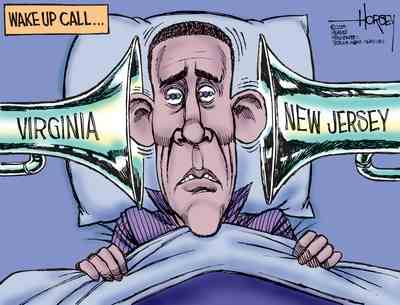- MENU
- HOME
- SEARCH
- WORLD
- MAIN
- AFRICA
- ASIA
- BALKANS
- EUROPE
- LATIN AMERICA
- MIDDLE EAST
- United Kingdom
- United States
- Argentina
- Australia
- Austria
- Benelux
- Brazil
- Canada
- China
- France
- Germany
- Greece
- Hungary
- India
- Indonesia
- Ireland
- Israel
- Italy
- Japan
- Korea
- Mexico
- New Zealand
- Pakistan
- Philippines
- Poland
- Russia
- South Africa
- Spain
- Taiwan
- Turkey
- USA
- BUSINESS
- WEALTH
- STOCKS
- TECH
- HEALTH
- LIFESTYLE
- ENTERTAINMENT
- SPORTS
- RSS
- iHaveNet.com: Politics
Tom Davis

Obama's Wake-Up Call (© David Horsey)
Tom Davis, a Virginia Republican, served in the
The 2009 off-year elections in Virginia, New Jersey, and New York's 23d Congressional District offer a small snapshot of the current views and motivations of the American electorate. While there may be a desire to extrapolate the events of Nov. 3, 2009 into a prediction of what will happen on Nov. 2, 2010, that is impossible. A year is an eternity in politics, and there are many variables that will affect the mood of the electorate: Where will unemployment be? How will healthcare reform turn out? What will be the status of Afghanistan and Iraq 12 months from now? Will the administration face a natural disaster or a foreign policy crisis? If so, how will it respond?
Nevertheless, voters this past week sent many messages to the political establishment in both parties that should be heeded. Here are seven key lessons:
1. Voter enthusiasm among Democrats, particularly the young voters and African-Americans who catapulted Barack Obama and the Democrats to power in 2008, has waned. Much of the Democratic energy over the past couple of election cycles has been fueled by antipathy to George W. Bush and his administration. With Bush gone and the Democrats in control, that energy is gone as well. It has been replaced by aroused Republicans and independents, tea parties, and angry taxpayers.
Elections are determined by who shows up, not who is registered. In Virginia, Republicans and conservative independents dominated the turnout, sweeping in the entire statewide
Put into historical context, the Virginia results should be no surprise. The party out of the
In New Jersey, Democratic turnout among minorities dropped precipitously, and independents and "blue-collar Reagan Democrats" voted to elect a Republican governor.
Voter anger is directed against the political establishment, which happens to be dominated by Democrats. However, it would be a mistake to read this as a pro-Republican trend.
2. A much closer than expected New York mayoral win for Michael Bloomberg, and an insurgency against the GOP House candidate chosen by party bosses in New York's 23d district demonstrate that voter anger can turn on Republicans and incumbents in general. In Virginia, Republican Bob McDonnell was able to focus and unite voter frustrations against the Democratic ticket.
The challenge for Republicans is to unite this voter frustration under their banner to be successful in 2010. In the New York House race, the Republican nominee, a state assemblywoman selected by party leaders, was rejected by conservatives, who attracted national attention to third-party conservative nominee Doug Hoffman. After weeks of negative attacks from the Democrats and the conservative, the
3. Democrats control both Houses of
Back-to-back Democratic landslides in 2006 and 2008 have led House Democrats to over-perform, leaving little room for additional gains in 2010. Moreover, the Obama turnout of liberals, minorities, and young people is unlikely to be repeated, leaving Democrats swept in by huge turnouts in 2008 at the mercy of a smaller, more conservative electorate in 2010. Ultimately, the unemployment rate and events in Afghanistan will shape an electorate already predisposed to be more hostile to Democrats than in 2008.
4. Republicans face a tough draw in the
5. Unlike in 1994, few vulnerable Democratic seats are currently open heading into the mid-terms. In 1994, the
Also in 1994, the House GOP had been out of power for 40 years. No one could really fathom or relate to what a Republican takeover would mean, except change. In 2010, many voters still have a bitter aftertaste from
6. Republican recruiting in both the House and
7. Taxes continue to be toxic. In Virginia, Democrat Creigh Deeds suggested he might raise taxes, while Republican Bob McDonnell said he wouldn't. High-income suburbs like Loudoun and Fairfax counties, which had voted Democratic for Obama, Tim Kaine, and Jim Webb, snapped back to give the Republicans the advantage (Loudoun with 60 percent), with the
In New Jersey, Somerset County, which had gone for Obama, went big for Republican Chris Christie, along with wealthy Morris County. More troubling for Democrats, blue-collar lunch bucket Democrats in Middlesex, Passaic, and across New Jersey reacted to high taxes.
In Virginia, an even harsher reaction to cap-and-trade policies of the Obama administration pushed coal-country counties strongly into the Republican column. The
In closing, the marching orders for the two parties are clear. Democrats must get the economy and Afghanistan under control. High unemployment for the electorate will equate to higher unemployment for Democrats. Similarly, American casualties and the perception of a mismanaged campaign against the Taliban will spell trouble at the ballot box.
For their part, Republicans must tame the whirlwind of discontent into focused, disciplined campaigns against Democratic candidates. If the party continues to fight among itself, the enthusiasm and intensity exhibited Tuesday will flame out and result in nothing.
Receive our political analysis by email by subscribing here
AMERICAN POLITICS
WORLD | AFRICA | ASIA | EUROPE | LATIN AMERICA | MIDDLE EAST | UNITED STATES | ECONOMICS | EDUCATION | ENVIRONMENT | FOREIGN POLICY | POLITICS
© Tribune Media Services